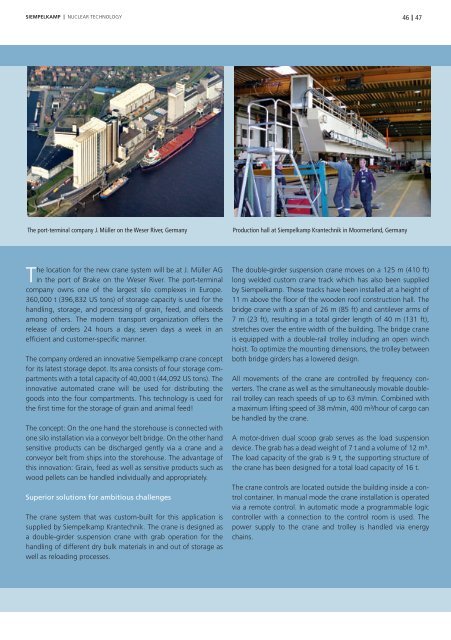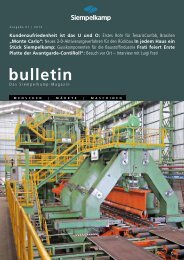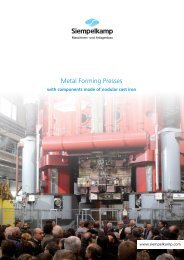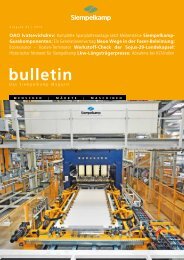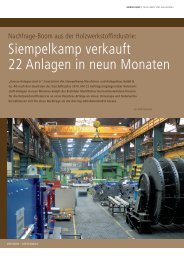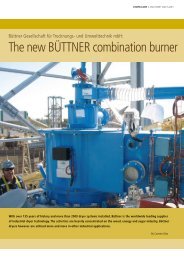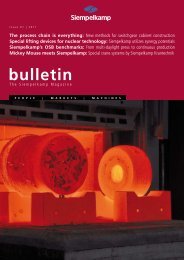Bulletin 2/2010 - Siempelkamp NIS
Bulletin 2/2010 - Siempelkamp NIS
Bulletin 2/2010 - Siempelkamp NIS
Create successful ePaper yourself
Turn your PDF publications into a flip-book with our unique Google optimized e-Paper software.
SIEMPELKAMP | NUCLEAR TECHNOLOGY<br />
The port-terminal company J. Müller on the Weser River, Germany Production hall at <strong>Siempelkamp</strong> Krantechnik in Moormerland, Germany<br />
The location for the new crane system will be at J. Müller AG<br />
in the port of Brake on the Weser River. The port-terminal<br />
company owns one of the largest silo complexes in Europe.<br />
360,000 t (396,832 US tons) of storage capacity is used for the<br />
handling, storage, and processing of grain, feed, and oilseeds<br />
among others. The modern transport organization offers the<br />
release of orders 24 hours a day, seven days a week in an<br />
effi cient and customer-specifi c manner.<br />
The company ordered an innovative <strong>Siempelkamp</strong> crane concept<br />
for its latest storage depot. Its area consists of four storage compartments<br />
with a total capacity of 40,000 t (44,092 US tons). The<br />
innovative automated crane will be used for distributing the<br />
goods into the four compartments. This technology is used for<br />
the fi rst time for the storage of grain and animal feed!<br />
The concept: On the one hand the storehouse is connected with<br />
one silo installation via a conveyor belt bridge. On the other hand<br />
sensitive products can be discharged gently via a crane and a<br />
conveyor belt from ships into the storehouse. The advantage of<br />
this innovation: Grain, feed as well as sensitive products such as<br />
wood pellets can be handled individually and appropriately.<br />
Superior solutions for ambitious challenges<br />
The crane system that was custom-built for this application is<br />
supplied by <strong>Siempelkamp</strong> Krantechnik. The crane is designed as<br />
a double-girder suspension crane with grab operation for the<br />
handling of different dry bulk materials in and out of storage as<br />
well as reloading processes.<br />
The double-girder suspension crane moves on a 125 m (410 ft)<br />
long welded custom crane track which has also been supplied<br />
by <strong>Siempelkamp</strong>. These tracks have been installed at a height of<br />
11 m above the fl oor of the wooden roof construction hall. The<br />
bridge crane with a span of 26 m (85 ft) and cantilever arms of<br />
7 m (23 ft), resulting in a total girder length of 40 m (131 ft),<br />
stretches over the entire width of the building. The bridge crane<br />
is equipped with a double-rail trolley including an open winch<br />
hoist. To optimize the mounting dimensions, the trolley between<br />
both bridge girders has a lowered design.<br />
All movements of the crane are controlled by frequency converters.<br />
The crane as well as the simultaneously movable doublerail<br />
trolley can reach speeds of up to 63 m/min. Combined with<br />
a maximum lifting speed of 38 m/min, 400 m³/hour of cargo can<br />
be handled by the crane.<br />
A motor-driven dual scoop grab serves as the load suspension<br />
device. The grab has a dead weight of 7 t and a volume of 12 m³.<br />
The load capacity of the grab is 9 t, the supporting structure of<br />
the crane has been designed for a total load capacity of 16 t.<br />
The crane controls are located outside the building inside a control<br />
container. In manual mode the crane installation is operated<br />
via a remote control. In automatic mode a programmable logic<br />
controller with a connection to the control room is used. The<br />
power supply to the crane and trolley is handled via energy<br />
chains.<br />
46<br />
47


